Pros
Cons
Introduction
The CM5 is the sister model to the new PM5, which offers a more familiar 'Flip-like' design, four different colors to choose from, a unique swivel lens, and a price tag that's $30 cheaper. The Bloggie CM5 comes only in eggplant purple, but it does have the 5x optical zoom that many crave.
Update: The Flip UltraHD was ultimately selected as our 2009 Ultracompact Camcorder of the Year. To see why we selected it and read about our other awards, check out the 2009 CamcorderInfo.com Select Awards.
Design
Front
{{section_header}}{{section.name}}{{/section_header}}

Back
{{section_header}}{{section.name}}{{/section_header}}

Left
{{section_header}}{{section.name}}{{/section_header}}
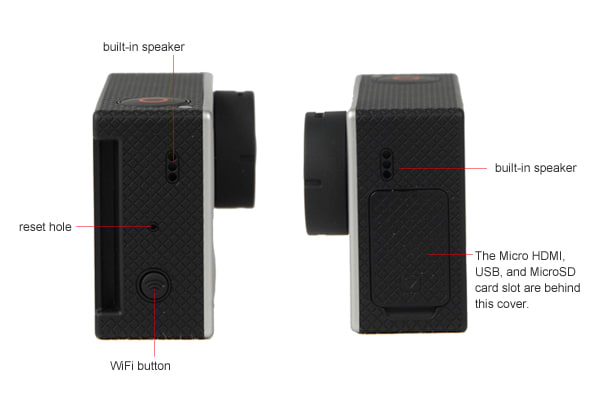
Right
{{section_header}}{{section.name}}{{/section_header}}
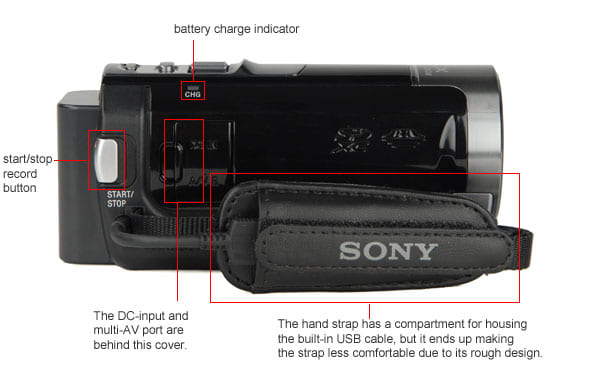
Top
{{section_header}}{{section.name}}{{/section_header}}

Bottom
{{section_header}}{{section.name}}{{/section_header}}

Size & Weight Comparison
{{section_header}}{{section.name}}{{/section_header}}
In the Box
{{section_header}}{{section.name}}{{/section_header}}

Performance
Color
{{section_header}}{{section.name}}{{/section_header}}
The Bloggie MHS-CM5 did not perform well in our bright light color testing. Compared to most of the competition, the Bloggie was very inaccurate in its rendering of pretty much every hue. For these results, you can thank the mediocre automatic white balance, which simply couldn't handle ordinary halogen lighting. In outdoor conditions, the Bloggie fares better. Unfortunately, a lot of consumers need to record indoor events. More on how we test color.
In the color error chart above, you can see how the Bloggie skewed many of the colors on our Chroma DuMonde chart. Yellow and orange hues were especially inaccurate. In the image capture from our train footage (below), you can see that the colors aren't particularly vibrant, except for the oversaturated reds. And since there aren't any additional color modes (like soft skin), any color adjustment tools (like saturation), or even a manual white balance, you're stuck with whatever the Bloggie gives you.
The image above might not look that bad, but compare the Bloggie's performance to that of these three competing models:
The Flip UltraHD had similar problems with the auto white balance, only colors were skewed cool instead of warm. The Sony Webbie MHS-CM1 (the 2009 predecessor to the Bloggie), had surprisingly good auto white balance, but was very washed out. What's the source of that gorgeous crop in the lower-left? That's the Sanyo Xacti VPC-CG10. Admittedly, the CG10 has a manual white balance, which helped that camcorder produce very accurate colors. However, the CG10 is also just an all-around better performer than any of these budget cams. It's also about the same price. The downside? The CG10 is not nearly as easy to use.
{{comparison_bars title="Color Score Comparison", attribute="Color Score", xLabel="Color Score"}}
Low Light Color
{{section_header}}{{section.name}}{{/section_header}}
The low light color results are about average for the Bloggie. The 4.85 color error is a slight improvement over the results boasted by last year's MHS-CM1. It also fared better in low light than in bright light. The horrible white balance issues in bright light were all but absent when we dimmed the lights. More on how we test low light color.
In the color error map above, you can see that the low light performance rendered inaccurate purples and greens, but the oranges and yellows are more accurate than they were in bright light.
You can see in the crops below that the CM5 does appear darker at 60 lux than the competition. The colors, however, are bold and accurate—though not quite as nice to look at as the colors produced by the Sanyo VPC-CG10.
Noise
{{section_header}}{{section.name}}{{/section_header}}
The bright light noise performance of the Bloggie CM5 is just below average for a camcorder of its class. Many budget camcorders are able to do well in this test, but it usually comes at a price: the lower resolution, the more likely it is that noise is washed out. The CM5 manages to have both impressive sharpness and impressive clarity: the noise percentage was only 0.6625%. More on how we test noise.
The crops above demonstrate the variation in noise that you see on the different models. The two Sony camcorders definitely have a sheen of fine noise that isn't present on the CG10 or the Flip UltraHD. However, the Sony cams are also sharper than either competing model—you can really see the incredible detail of the Bloggie in its vertical trumpet. The Flip doesn't have great sharpness and it also has some discoloration that you don't get in the other models.
{{comparison_bars title="Noise Score Comparison", attribute="Noise Score", xLabel="Noise Score"}}
Low Light Sensitivity
{{section_header}}{{section.name}}{{/section_header}}
Sony has made one very important improvement to its ultracompact line. The Bloggie MHS-CM5 performed much better on our low light sensitivity test than last year's Webbie fared. The Bloggie required just 12 lux of light in order to output 50IRE. By contrast, the Webbie CM1 needed an abominable 27 lux. The Bloggie's performance is about average for a consumer camcorder—not great, but not horrible either. The Webbie's performance last year was just awful. More on how we test low light sensitivity.
These results were achieved by testing the Bloggie at its maximum resolution of 1920 x 1080. The frame rate at this resolution is 30p, which typically turns in a better sensitivity score than 60i or 60p. (However, 30p also tends to have more motion trailing in low light.) The Bloggie, unlike most ultracompact camcorders, does have alternate frame rates available. However, the 60p setting will not improve low light sensitivity and it's only available in a1280 x 720 resolution.
{{comparison_bars title="Low Light Sensitivity Comparison", attribute="Low Light Sensitivity Score", xLabel="Low Light Sensitivity Score"}}
Low Light Noise
{{section_header}}{{section.name}}{{/section_header}}
The CM5 definitely produced more noise in low light than it did in our bright light tests. The noise percentage in low light was 1.015%, which is above average for any consumer camcorder. More on how we test low light noise.
The only camcorder that consistently performed better in the noise department is the Flip UltraHD. As we said in the bright light noise section, the Flip does well in the noise tests because its low sharpness causes all of the noise to be obscured by blurriness. The Bloggie maintains both a clear image and high resolution.
{{comparison_bars title="Low Light Noise Score Comparison", attribute="Low Light Noise Score", xLabel="Low Light Noise Score"}}
Low Light Color
{{section_header}}{{section.name}}{{/section_header}}
The low light color results are about average for the Bloggie. The 4.85 color error is a slight improvement over the results boasted by last year's MHS-CM1. It also fared better in low light than in bright light. The horrible white balance issues in bright light were all but absent when we dimmed the lights. More on how we test low light color.
In the color error map above, you can see that the low light performance rendered inaccurate purples and greens, but the oranges and yellows are more accurate than they were in bright light.
You can see in the crops below that the CM5 does appear darker at 60 lux than the competition. The colors, however, are bold and accurate—though not quite as nice to look at as the colors produced by the Sanyo VPC-CG10.
Motion
{{section_header}}{{section.name}}{{/section_header}}
Sony definitely improved the motion performance on the MHS-CM5, thus making it one of the better ultracompact camcorders in this test. The CM5 didn't show much artifacting in our motion test, although some was definitely noticeable (particularly in the RGB pinwheel on the left portion of the test video). The video captured by the camcorder was also decently smooth, despite the fact that the camcorder records 1080p footage using a 30p frame rate. More on how we test motion.
Video Sharpness
{{section_header}}{{section.name}}{{/section_header}}
The Bloggie continues Sony's tradition of exemplary sharpness performance in its budget camcorders. Last year's Webbie MHS-CM1 shocked us with its impressive sharpness and this year's model was much the same. The Bloggie MHS-CM5 demonstrated a horizontal sharpness of 800 lw/ph and a vertical sharpness of 600 lw/ph. This is an excellent performance for an inexpensive camcorder. More on how we test video sharpness.
{{comparison_bars title="Video Sharpness Score Comparison", attribute="Video Sharpness Score", xLabel="Video Sharpness Score"}}
Testing Samples
{{section_header}}{{section.name}}{{/section_header}}
Usability
Ease of Use
{{section_header}}{{section.name}}{{/section_header}}
Ease-of-use is the cornerstone of the ultracompact camcorder. In this regard, Sony has made some major improvements to make this year's Bloggie simpler and less intimidating than last year's Webbie. The main improvement is a simple reduction in the number of features. Sony has figured out that consumers in this demographic don't want a lot of scene modes and choices. That being said, there are still a lot more options than what you have on the Flip line of camcorders.
Fortunately, these options are a lot easier to access than they were on the Webbie camcorder. There is a small Menu button located within the LCD cavity. It's clearly labeled and does exactly what you expect it to do. Unfortunately, there are two options that are only available via a joystick shortcut: self-timer and display on/off/auto. The joystick is technically labeled to indicate these options, but we think most people won't see that. In fact, if you accidentally click up or down on the joystick, it can be disorienting when the Bloggie pops up this unwanted option.
Aside from these two features, the Bloggie is very easy to use. There are helpful tool tips to give a short explanation of features within the settings menu. Any features that do not have tool tip explanation are fairly self-explanatory. The menu display can be changed to yellow, pink, or blue. Available languages for the North American version of the Bloggie include English, French, Spanish, and Chinese.
If you need additional guidance, there are rather lengthy 'Operating Instructions available. It's probably more information that a Bloggie user would ever want to have, but for instruction manual collectors, it's a veritable gold mine.
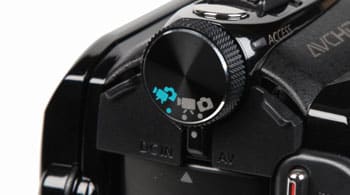
Auto Mode is confusingly called Dual Shot mode
Auto Mode
{{section_header}}{{section.name}}{{/section_header}}
It should come as no surprise that the Bloggie is an auto-only camcorder. Like most ultracompact budget cams, the CM5 does not have manual controls; it's 100% cruise control for Bloggie fans.
Unfortunately, these automatic adjustments are not always responsive or effective. Auto exposure was often unnecessarily slow, especially when going from a particularly bright environment to darker areas. The usual troubles with indoor lighting cropped up with the auto white balance, but the camcorder fared considerably better than the Kodak Zx3 and Zi8.
Of all the automatic image adjustments, focus was the most troubling. At times, we would shoot footage only to find later that half the frame was out of focus. This was reminiscent of the troubles we had with the JVC Picsio—only that was a lens problem and not a flaw in the autofocus. We're not really sure which problem is worse: the inconsistent focus of the Bloggie or the Zi8's complete lack of focus for anything between 6 inches and 6 feet away. Probably the latter.
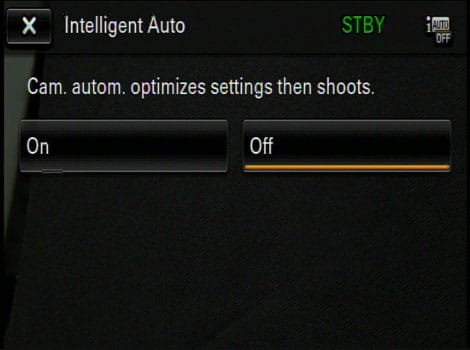
The iAuto mode button is difficult to find, but when you do find it the option for turning on the mode looks like this.
Auto Controls
{{section_header}}{{section.name}}{{/section_header}}
Focus - There is no manual focus option on the Bloggie. Instead, you'll have to let the autofocus do its job. On most of the competition, this means just pointing at your subject and enjoying the ride, since most ultracompacts have a fixed focal length. The Bloggie, which should have an advantage with its moving lens elements, is actually terrible at focusing. The problem is described above in the auto mode section.
Exposure - The Bloggie MHS-CM5 does not have an option for manual exposure control. As is true with most ultracompacts, you're stuck with the automatic exposure adjustment. Fortunately, the auto exposure works fine, even if it's sometimes painfully slow.
Handling
{{section_header}}{{section.name}}{{/section_header}}
The Sony MHS-CM5 Bloggie handles much like other pistol-grip camcorders. In this regard, it's completely different from its horizontal predecessor, the MHS-CM1. If you're familiar with the Sony Handycam lineup, the Bloggie CM5 is most reminiscent of the HDR-TG5. Both the TG5 and the CM5 have an upright design and can be handled easily in either the left hand or the right hand. However, the considerably more expensive TG5 will get you not just better quality video, but also a sturdier design, better button placement, and a a more comfortable grip.

The CM5 is designed more like the Xacti series from Sanyo. It's less rectangular than Sony's TG5 and feels as cheap and lightweight as the VPC-CG10. Unfortunately, we also found that the Xacti has a better design. Its joystick is easier to use and the buttons rest more comfortably beneath the thumb. The Bloggie felt slippery in our hands—partly because of the slick surface and partly because of the awkward shape. It's actually easier to use in the left hand, where the weight of the lens doesn't pull the controls out from under your thumb.

The majority of functions are activated using the small, rear-mounted joystick. This tiny control can be difficult to maneuver, especially when you're trying to manipulate the subtle difference between pushing down on the center of the joystick and pushing it in one of the cardinal directions. It's all too easy to accidentally select something when you'd rather be scrolling through the menu. Fortunately, there aren't many reasons to be mucking about in the menus. So you can usually avoid this headache.
If you absolutely have to use the joystick, you'll want two hands: a second hand can steady the camcorder while the thumb of your main hand gets a better grip on the joystick.


These dedicated buttons give you quick access to aperture and shutter speed controls.
Portability
{{section_header}}{{section.name}}{{/section_header}}
The Bloggie CM5 is certainly a portable camcorder, especially compared to more traditional consumer camcorders. It's also easier to tote around that its predecessor, the Webbie MHS-CM1. However, it's not quite as convenient as the Flip style of camcorder, which is thinner, smaller, and flatter.
Battery Life
{{section_header}}{{section.name}}{{/section_header}}
The Sony Bloggie MHS-CM5 had a moderate battery life performance, outlasting the Flip UltraHD and the Sanyo VPC-CG10. Surprisingly, however, the CM5 did not fare as well as last year's MHS-CM1, which boasted incredibly impressive battery life. All told, the CM5 lasted about 107 minutes (1hr, 47m, 13s). More on how we test battery life.
The Bloggie does have a removable battery, so it's possible to purchase a spare battery if you're anticipating longer shoots. The cavity is, however, enclosed; you won't be able to upgrade to a larger battery pack. The NP-BK1 battery can only be recharged via USB. (There is no DC power input on the Bloggie.)

{{comparison_bars title="Battery Life Comparison", attribute="Battery Life Score", xLabel="minutes"}}
LCD
{{section_header}}{{section.name}}{{/section_header}}
The Sony Bloggie MHS-CM5 has a rather lackluster 2.5-inch LCD, with 230,000-pixel resolution. This isn't particularly impressive, especially for an LCD panel that flips out from the body of the camcorder. For ultracompact camcorders that have no flip-out LCD, this size is to be expected. But the Sanyo Xacti VPC-CG10 has nearly the same body design and sports a 3-inch LCD. On the other hand, Sony has improved its LCD specs since last year's Webbie (MHS-CM1). The worst part of the LCD panel may be the huge, blank bezel surrounding the tiny display. This makes the Bloggie feel look like a cheap, antiquated piece of technology.
There is a backlight option on the Bloggie's LCD, but no other features or adjustments to be made. Having a flip-out LCD panel does help with glare, but we think a larger display would have been a nice touch. The Bloggie, like all ultracompact camcorders, does not have a viewfinder. This means you'll be lining up all your shots via this small LCD.
The LCD on the Bloggie is not a touchscreen; all controls are made via the small joystick.
Stabilization
{{section_header}}{{section.name}}{{/section_header}}
The Bloggie features digital image stabilization—a feature that was not available on last year's Webbie lineup. Unfortunately, SteadyShot is not available when shooting in either 1080/30p or 720/60p modes... it's only available in 720/30p or VGA. That's certainly a significant limitation, since most consumers that are worried about shakiness are also worried about shooting reasonably high quality video. More on how we test stabilization.
Of course, even if you are willing to shoot in one of the lower quality settings, you won't find the stabilization to be particularly effective.
As you can see from the table above, the difference in shake is only very slight, even in our low shake test. The Bloggie registered a 19% shake reduction on low shake and just a 2% shake reduction under high shake conditions.
Most camcorders in this category do not have any kind of shake reduction. The Sanyo Xacti VPC-CG10 employed a digital image stabilization system that did virtually nothing to improve camcorder performance in our shake test. Last year's Sony Webbie and the Flip series of ultracompact camcorders do not advertise any image stabilization.
Manual Focus
{{section_header}}{{section.name}}{{/section_header}}
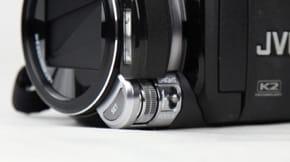
The adjustment dial makes accurate focus adjustments easy.
Manual Exposure
{{section_header}}{{section.name}}{{/section_header}}
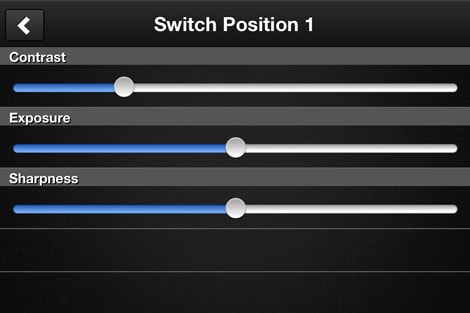
The manual exposure controls are only found on the Contour app, not on the camcorder itself.
Miscellaneous Controls
{{section_header}}{{section.name}}{{/section_header}}
Without any of the more commonplace image controls (like exposure and white balance), it should come as no surprise that the Bloggie has no real specialty controls either. The MHS-CM5 really isn't marketed toward a demographic that would be interested in manually tweaking color depth or sharpness. There is, however, one interesting feature to note:
Flicker Reduction
According to the Bloggie's user manual, this feature: 'curbs the flicker generated by fluorescent lights by using the electro-shutter.' We did not notice any difference.
Auto Controls
{{section_header}}{{section.name}}{{/section_header}}
Focus - There is no manual focus option on the Bloggie. Instead, you'll have to let the autofocus do its job. On most of the competition, this means just pointing at your subject and enjoying the ride, since most ultracompacts have a fixed focal length. The Bloggie, which should have an advantage with its moving lens elements, is actually terrible at focusing. The problem is described above in the auto mode section.
Exposure - The Bloggie MHS-CM5 does not have an option for manual exposure control. As is true with most ultracompacts, you're stuck with the automatic exposure adjustment. Fortunately, the auto exposure works fine, even if it's sometimes painfully slow.
Audio Controls
{{section_header}}{{section.name}}{{/section_header}}
There aren't really any audio features on the Sony Bloggie MHS-CM5. There is a tiny, strangely placed mono microphone on the top edge of the LCD panel. And... that's it. There's no way to adjust audio volume, there's no microphone input, and there aren't even any gimmicky features like Wind Cut.
Editing
{{section_header}}{{section.name}}{{/section_header}}
Both entries in the Bloggie series ship with the built-in Picture Motion Browser (PMB) Portable and regular Picture Motion Browser (PMB). Neither is as simple to use as Flip Video or as fully featured as what probably came with your Operating System. The good news is that this year's PMB Portable is compatible with PCs and, for the first time, Macs.
Whatever program you end up using, one thing is certain: the MPEG4 files that are recorded by the Bloggie are easier to edit than the large and sometimes frustrating AVCHD files recorded by more expensive HD camcorders. For an overview of the software that ships with this and other camcorders, see our article: Video Editing Software For Your Camcorder{{product.brand.name}}-Included-Software.htm.
Features
Compression
{{section_header}}{{section.name}}{{/section_header}}
The Sony Bloggie MHS-CM5 (and its sister model, the PM5) record in the standard MPEG4 AVC/H.264 format. This format is easier to edit than the large AVCHD files recorded by full-featured HD camcorders.
Also new this year, the Bloggie lineup has a native 60p recording mode and a full 1920 x 1080 30p mode that were not present on last year's Webbie line. It's a shame that the 60p mode tops out at a resolution of 1280 x 720—recording in full HD is only possible at 30fps. Sony does not publish the bitrate of the Bloggie camcorders, but we estimate the maximum to be approximately 7Mbps. Read more about the advantages and disadvantages of various high definition compression types.
Media
{{section_header}}{{section.name}}{{/section_header}}
The CM5, like all Sony camcorders this year, has a single memory card slot that is compatible with either MemoryStick PRO Duo cards or traditional SD/SDHC memory cards. The Bloggie is not compatible with SDXC cards, but we are pleasantly surprised that Sony has adapted to allow consumers to use non-proprietary media.
There is also a small amount of internal memory on the CM5, but not enough to record video. (It's primarily reserved for the built-in editing software.) Below is a table of maximum record times, based on selected media. Regardless of the capacity of your media, you will only be able to shoot continuously for approximately 29 minutes. Read more about the advantages and disadvantages of various media types.

Slow Motion Modes
Still Features
{{section_header}}{{section.name}}{{/section_header}}
The Sony MHS-CM5 is not a good option if you're looking for a true video-photo hybrid. The photo quality is very low and there just aren't a lot of options to add versatility to the photos you shoot. In a pinch, however, you can certainly use the Bloggie to capture some meager still shots. The maximum resolution isn't bad (2592 x 1944) and at least it takes photos at all, which is more than you can say for the Flip lineup.
In terms of options, the only thing Sony really provides is a self-timer. You can't capture photos while recording video and there's no flash, manual controls, continuous shot, or bracketing. That said, the size options alone put the Bloggie on even footing with most ultracompacts these days. The only competing model that outstrips the Bloggie is the tremendously Sanyo VPC-CG10. This little Xacti has tons of still photo options and good quality too. It isn't as easy to use as the Flip and its clones, but the Sanyo's offerings are impressive in this department.
Sony's ultracompact camcorders turn in still color performance that's just above average for their class. When compared to many higher priced camcorders and, especially, to dedicated still cameras, this is a poor performance. The color accuracy was 7.13, while saturation was measured at 131.6%,
In terms of our still photography noise testing, the Bloggie was very poor indeed. Its captured photos were even noisier than those of last year's MHS-CM1 Webbie—and those were really noisy. The alarming noise percentage of 1.77% is yet one more reason to only use the Bloggie for photos in a pinch. The Sanyo VPC-CG10, on the other hand, aced this test. This is yet another reason to buy the Sanyo if you're looking for a video-still hybrid.
Still sharpness was probably the Bloggie's strongest performance in our still photography testing. As was the case with video sharpness, the Bloggie managed to capture more fine detail than most of the competition. The CM5 measured a horizontal sharpness of 1919 lw/ph, with just 7.8% oversharpening. The vertical sharpness measured 1703 lw/ph with an oversharpening of 12.6%. These score are quite good for an ultracompact camcorder—though not as impressive as the sharp results of the VPC-CG10.
Lens & Imaging System
{{section_header}}{{section.name}}{{/section_header}}

The Sony Bloggie MHS-CM5 features essentially the same lens and sensor as last year's MHS-CM1. The focal range and aperture of the lens, as well as the size and resolution of the sensor are all virtually identical. One thing that Sony has managed to improve slightly is the wide angle of the lens. This probably has more to do with the housing of the lens than the lens itself.
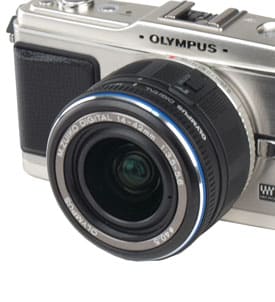
LCD
{{section_header}}{{section.name}}{{/section_header}}
The Sony Bloggie MHS-CM5 has a rather lackluster 2.5-inch LCD, with 230,000-pixel resolution. This isn't particularly impressive, especially for an LCD panel that flips out from the body of the camcorder. For ultracompact camcorders that have no flip-out LCD, this size is to be expected. But the Sanyo Xacti VPC-CG10 has nearly the same body design and sports a 3-inch LCD. On the other hand, Sony has improved its LCD specs since last year's Webbie (MHS-CM1). The worst part of the LCD panel may be the huge, blank bezel surrounding the tiny display. This makes the Bloggie feel look like a cheap, antiquated piece of technology.
There is a backlight option on the Bloggie's LCD, but no other features or adjustments to be made. Having a flip-out LCD panel does help with glare, but we think a larger display would have been a nice touch. The Bloggie, like all ultracompact camcorders, does not have a viewfinder. This means you'll be lining up all your shots via this small LCD.
The LCD on the Bloggie is not a touchscreen; all controls are made via the small joystick.
Connectivity
{{section_header}}{{section.name}}{{/section_header}}
All of the a/v ports for the Bloggie are located in a single cavity, which is hidden by a sturdy hinged cover. The most prominent connection inside this cavity is a stubby little USB arm that flips out from the camcorder. The design isn't nearly as slick as that of the Flip series, but you do have the convenience of a USB connection built right into the body. Unfortunately, this arm is so short and rigid that most people will have a lot of trouble actually plugging it into their computer. You're much better off using the USB extension cable that ships with the Bloggie.
Also nestled inside the cavity are a mini-HDMI output and AV output. The HDMI connection is a universal jack that will work with any mini-HDMI to HDMI cable. The AV output, however, works only with Sony proprietary cables. The Bloggie ships with standard composite cables, but you'll need to purchase proprietary Sony component cables separately if you want to use that connection.
There is one additional port of interest: the memory card slot. This is nestled in the same cavity as the battery and is the primary recording media for the Bloggie. An exciting new feature this year: all Sony consumer camcorders carry a memory card slot that is compatible with both standard SD/SDHC memory cards or the proprietary Sony MemoryStick PRO Duo cards. We couldn't be happier with this addition from Sony.
Battery
{{section_header}}{{section.name}}{{/section_header}}
The Bloggie does have a removable battery, so it's possible to purchase a spare battery if you're anticipating longer shoots. The cavity is, however, enclosed; you won't be able to upgrade to a larger battery pack. The NP-BK1 battery can only be recharged via USB. (There is no DC power input on the Bloggie.)

Media
{{section_header}}{{section.name}}{{/section_header}}
The CM5, like all Sony camcorders this year, has a single memory card slot that is compatible with either MemoryStick PRO Duo cards or traditional SD/SDHC memory cards. The Bloggie is not compatible with SDXC cards, but we are pleasantly surprised that Sony has adapted to allow consumers to use non-proprietary media.
There is also a small amount of internal memory on the CM5, but not enough to record video. (It's primarily reserved for the built-in editing software.) Below is a table of maximum record times, based on selected media. Regardless of the capacity of your media, you will only be able to shoot continuously for approximately 29 minutes. Read more about the advantages and disadvantages of various media types.

Still Features
{{section_header}}{{section.name}}{{/section_header}}
The Sony MHS-CM5 is not a good option if you're looking for a true video-photo hybrid. The photo quality is very low and there just aren't a lot of options to add versatility to the photos you shoot. In a pinch, however, you can certainly use the Bloggie to capture some meager still shots. The maximum resolution isn't bad (2592 x 1944) and at least it takes photos at all, which is more than you can say for the Flip lineup.
In terms of options, the only thing Sony really provides is a self-timer. You can't capture photos while recording video and there's no flash, manual controls, continuous shot, or bracketing. That said, the size options alone put the Bloggie on even footing with most ultracompacts these days. The only competing model that outstrips the Bloggie is the tremendously Sanyo VPC-CG10. This little Xacti has tons of still photo options and good quality too. It isn't as easy to use as the Flip and its clones, but the Sanyo's offerings are impressive in this department.
Sony's ultracompact camcorders turn in still color performance that's just above average for their class. When compared to many higher priced camcorders and, especially, to dedicated still cameras, this is a poor performance. The color accuracy was 7.13, while saturation was measured at 131.6%,
In terms of our still photography noise testing, the Bloggie was very poor indeed. Its captured photos were even noisier than those of last year's MHS-CM1 Webbie—and those were really noisy. The alarming noise percentage of 1.77% is yet one more reason to only use the Bloggie for photos in a pinch. The Sanyo VPC-CG10, on the other hand, aced this test. This is yet another reason to buy the Sanyo if you're looking for a video-still hybrid.
Still sharpness was probably the Bloggie's strongest performance in our still photography testing. As was the case with video sharpness, the Bloggie managed to capture more fine detail than most of the competition. The CM5 measured a horizontal sharpness of 1919 lw/ph, with just 7.8% oversharpening. The vertical sharpness measured 1703 lw/ph with an oversharpening of 12.6%. These score are quite good for an ultracompact camcorder—though not as impressive as the sharp results of the VPC-CG10.
Other Features
{{section_header}}{{section.name}}{{/section_header}}
PAL Output
The only notable feature on the Bloggie is the option to output to a PAL display. This can come in handy if you're either from Europe or planning to take the Bloggie on a European vacation.
Sanyo VPC-CG10 Comparison
The Sony MHS-CM5 represents a significant upgrade over last year's CM1. The most significant change is, of course, the form factor. The Bloggie is built with this upright, pistol-grip design, as opposed to the Webbie's traditional horizontal build. Neither camcorder handles particularly well, but the new Bloggie feels a little more comfortable and seems a lot more portable.
Performance is basically a wash, with the Bloggie performing better in some areas (like low light sensitivity and still sharpness) and the old Webbie performing better in other areas (like bright light color accuracy and battery life). The cornerstone of the ultracompact market, however, is ease of use. And in this regard, the new CM5 far outshines the CM1. Last year's model was crammed full of unnecessary and confusing buttons. The Bloggie layout is much more streamlined and will definitely appeal to novice users.
Just about the only thing we don't prefer about the 2010 model is the name. Webbie vs. Bloggie? Too bad this new cam doesn't have the superior branding.
Pure Digital Flip UltraHD Comparison
The new Bloggie—at least, the CM5 version of the Bloggie—is a lot like the Sanyo VPC-CG10 in its basic design. However, the two camcorders are very different in terms of performance and features. Last year's CG10 from Sanyo is packed full of manual controls, including independent aperture and shutter control, ISO adjustment, and a flash for still photos. It's also one heck of a still photo hybrid—head and shoulders above anything else in this price range.
The Sanyo also destroys the CM5 in bright light color and noise and still photo performance. The Bloggie, however, has a slight edge in low light and sharpness. Neither camcorder has particularly impressive image stabilization, but we did find the Bloggie to be a tad bit more effective in this area.
The CM5 is also a lot easier to use. There are very few buttons, options, and menus to clutter up the experience. If you're new to this kind of technology and anxious about using it, the Bloggie is a much better choice. If you feel comfortable navigating menus and you want some more options at your fingertips—plus an incredibly good still photo experience—the Sanyo Xacti VPC-CG10 is the camcorder for you.
COMP 3
The Flip line of ultracompact camcorders got there first and is still king of the castle. Quite simply, the Flip is a much simpler, more enjoyable user experience. It couldn't possibly be easier to use. The Bloggie is still a little more complicated to use and the handling isn't as straightforward or as comfortable—especially on this MHS-CM5 version of the Bloggie.
The Flip also continues to churn out excellent video quality, beating the Bloggie in nearly every performance category. In those areas where the Bloggie proved superior (i.e. sharpness and low light color accuracy), the difference is not significant. The Flip, on the other hand, boasted far superior numbers in low light sensitivity and had a much more accurate automatic white balance.
Two areas in which the Bloggie does have an advantage are in image stabilization and still photography. The Flip has no image stabilization, while Sony's model does have some minor digital stabilization. Unfortunately for Sony, this isn't much of an advantage, since the system doesn't work very well on the Bloggie. However, this may be a case of something is better than nothing. The Flip also has absolutely no still photo functionality. You can grab still images from the videos you record, but they are of very poor quality. The Bloggie boasts some moderate proficiency in taking still photos.
Even if you are determined to take still photos with your camcorder, there are a number of other models to consider, including the excellent Sanyo VPC-CG10. For a simple and high quality video recording experience, the Flip is the superior model.
Conclusion
We were very impressed with the improvements made to this year's Bloggie lineup from Sony. In particular, the Sony Bloggie MHS-CM5 (MSRP $199.99) is a far better product compared to last year's Webbie CM1. The form factor is better, the interface is simpler, and the inclusion of a duel SDHC-MemoryStick slot is commendable.
Unfortunately, we still can't find many compelling reasons to choose the Bloggie over the competition. The Flip is still easier to use and produces comparable—if not superior—video quality.
Just about the only advantage the Bloggie has over the Flip series is the ability to take still photos and the presence of a digital image stabilization system. Both of these features are present on other models, including the excellent Sanyo VPC-CG10, which far outstrips the Bloggie in terms of still photo features and performance. If you're a Sony devotee, the Bloggie will be a welcome upgrade over the Webbie, but we encourage consumers to look elsewhere for their ultracompact camcorder purchases.
Photo Gallery
{{photo_gallery "Front Photo", "Left Photo", "Left Open Photo", "Back Photo", "Right Photo", "Top Photo", "Bottom Photo", "Lens Photo", "Lens Photo 2", "3D Lens Photo", "Media Photo", "Easy Mode Photo", "Manual Controls Photo", "Zoom Photo", "Zoom Photo 2", "Ease of Use Photo", "Battery Photo", "LCD Photo 1", "LCD Photo 2", "EVF Photo 1", "EVF Photo 2", "Mic Photo", "Mic Photo 2", "Ports Photo 1", "Ports Photo 2", "Ports Photo 3", "Ports Photo 4", "Ports Photo 5", "Ports Photo 6", "Handling Photo 1", "Handling Photo 2", "Handling Photo 3", "Handling Photo 4", "Box Photo"}}
Meet the tester
Vice President of Editorial Management, Kaitlyn oversees the editorial departments of Reviewed.com’s various sites. She has been writing about technology since the turn of the century. Outside of her Reviewed.com home, Kaitlyn is also a theatre director and avid gamer.
Checking our work.
Our team is here to help you buy the best stuff and love what you own. Our writers, editors, and experts obsess over the products we cover to make sure you're confident and satisfied. Have a different opinion about something we recommend? Email us and we'll compare notes.
Shoot us an email